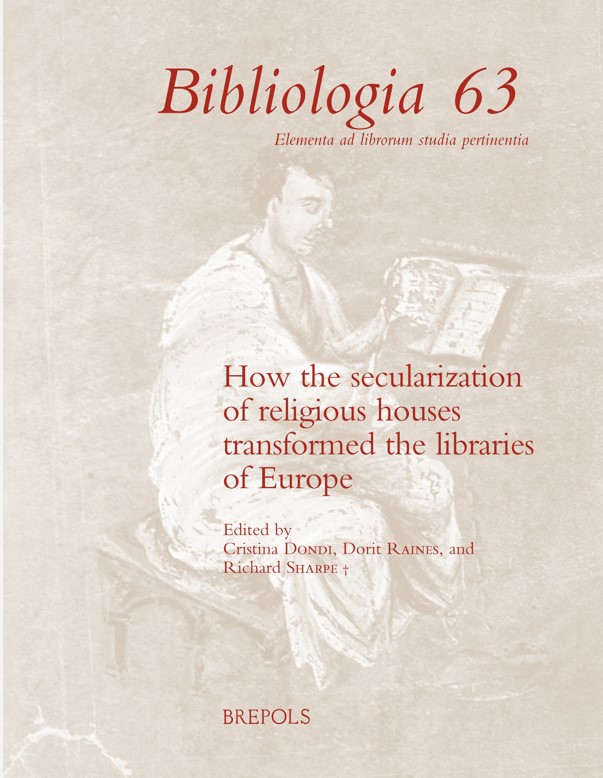Strictly speaking, it was over the last four decades of the eighteenth century that the abolition of religious orders and the suppression of their houses impacted on Spanish libraries. Subsequently, the great political upheavals of the nineteenth century, caused in particular by the confrontation between constitutional liberalism and absolutist conservatism, as well as by the Carlist Wars, had a direct effect on the religious orders in Spain, which experienced both suppression and restoration. In 1835 and 1836, the Desamortización Eclesiástica, or Nationalization of Church Property under the prime minister ship of Juan Álvarez Mendizábal (1790–1853), a progressive who briefly held office during the three-year liberal interlude of Ferdinand VII’s reign was, in fact, only the best-known of a long series of expropriations of ecclesiastical land and property that had begun in the eighteenth century and would continue throughout the nineteenth and into the twentieth 1 A series of civil wars that took place in Spain during the period 1833–1876. century. It was, for instance, followed by further confiscations under other progressive ministers Joaquín Fernández-Espartero (1793–1879) in 1841, and then under Pascual Madoz (1806–1870) in 1855. This was a gradual process which can be divided into three stages differentiated by the sort of property that was seized and put up for sale: 1767–1836, from Charles III (1716–1788) to Mendizábal, confiscation of estates associated with the Church and of the property of ecclesiastical institutions that had been suppressed; 1836–1841, from Mendizábal to Espartero, confiscation of property of the regular and secular clergy; 1855–1924, from Madoz to Primo de Rivera (1870–1930), confiscation of any remaining ecclesiastical, and also the sale of State-owned, property. These expropriations formed part of a policy of transferring property ownership with a view to increasing the nation’s wealth and, in the short and medium terms, to securing a windfall that would reduce public debt. The seizure and auctioning of property said in Spanish to be “en manos muertas”, that is, until then, legally inalienable possessions of the Church and the religious orders which held it in perpetuity, was officially decreed to be permissible by law. These decrees had the purpose of financing the liberal government.
En esta conferencia, celebrada en la Universidad de Oxford en 2012, este caso de estudio se encuadró en la Parte I: El mapa territorial y temporal de las colecciones canceladas, en el que se presentaron los trabajos siguientes:
Fiorenzo Landi (University of Bologna) – The dissolution of monasteries and convents in Europe. An overview of the economic implications
Richard Sharpe († University of Oxford) – Dissolution and dispersion in sixteenth-century England: understanding the remains
Rudolf Gamper (Vadianischen Sammlung St. Gallen) – Klosteraufhebungen und das Schicksal ihrer Bibliotheken in der Deutschschweiz
Jeffrey Garrett (formerly Northwestern University) – The expropriation of monastic libraries in German-speaking Europe, 1773–1817
Javier Antón Pelayo (Universidad Autónoma de Barcelona) – The Secularization of Spanish religious libraries (1767-1836): The Catalan case
Luís Cabral (formerly Biblioteca Pública Municipal do Porto) – Case study 1: Portugal, Porto – State policy concerning the dissolution of monastic book collections in Portugal, especially during the nineteenth century
María Luisa Lopez Vidriero (formerly Royal Library of Madrid) – Case study 2: Spain, Seville and Madrid – The formation of new libraries
Pedro Rueda Ramírez (University of Barcelona) – The secularization of religious houses in Latin America from independence to the new republics: the continuity and fragmentation of library collections
Está publicado en
How the Secularization of Religious Houses Transformed the Libraries of Europe, 16th-19th Centuries. Cristina Dondi , Dorit Raines , Richard Sharpe † (eds). Brepols, vol.63
The closure of religious houses, in varying circumstances, affected all of Europe at some point between the sixteenth and nineteenth century. At different times and in different countries the consequences were widely varied, in some cases preserving medieval and early modern collections intact, in others abandoning books to their fate, or transferring them piecemeal into new ownership to serve different cultural purposes. Integral preservation or dispersal may each be viewed in positive or negative terms. For religious and political history there are many, and bigger, factors involved, and the effects of secularization worked on many things beside libraries and books. None the less, by focusing on books and libraries through these changes a particular narrative emerges of great cultural importance. It is the most important book-historical story for the survival and accessibility of Europe’s heritage of the written word, one that interacts with major historical themes and still connects with future issues for the continuing role of books and libraries in the European heritage.
A conference held in Oxford in 2012 brought together thirty experts in different aspects of this process or with knowledge of its impact in different countries and at different periods. The result was to bring together and share for the first time the similar and different experiences of different European countries, from Portugal and Spain in the west to Poland and Ukraine in the east, from Finland and Sweden in the north to Naples in the south, with ramifications stretching to North and South America. While reading this volume of collected essays, the reader may notice a disparity in the evidence that each author has been able to bring to bear upon their subject. Provenance research is well advanced in some territories, less so in others. In the decade since the conference and this publication, there have been some attempts to bridge certain gaps. But in general, there has been little new work in the years since the conference took place. The editors anticipate that this publication will stimulate further research, bridging some of the gaps visible in the evidence presented in this volume. Multiple avenues for further investigation open up, indeed, in historical and cultural studies, such as the impact of the secularization on nonreligious libraries, and the change in attitude with respect to certain disciplines and even to erudition itself.

Deja una respuesta